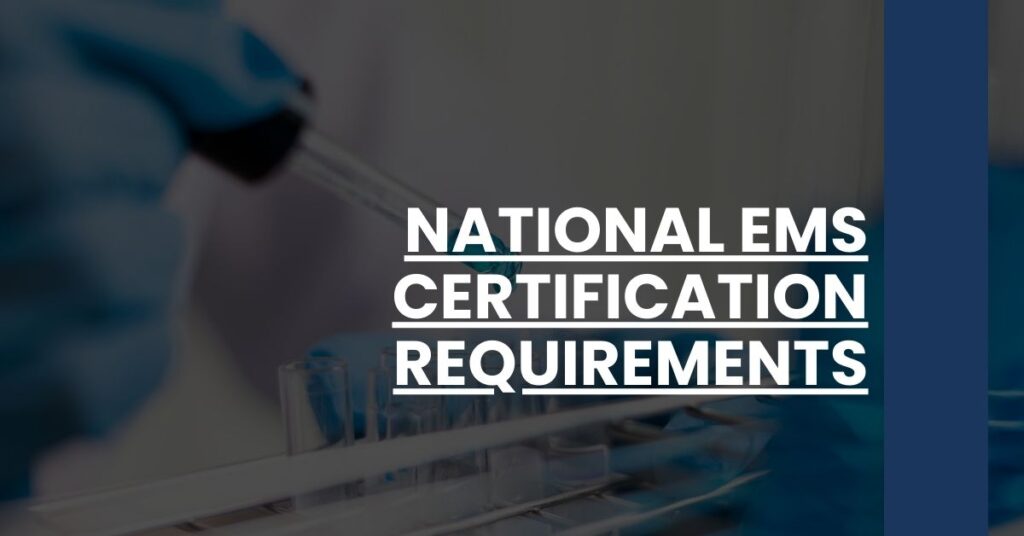National EMS certification requirements set the standard for excellence in emergency medical services.
- Understanding National EMS Certification Requirements: Learn about the significance and the overarching standards it establishes for EMS professionals.
- Education and Training Essentials: Uncover the minimum educational prerequisites and practical skillsets required for certification.
- Examining the Certification Process: Get to grips with the cognitive and psychomotor exams integral to obtaining national certification.
Your path to meeting National EMS certification requirements begins here.
- Understanding National EMS Certification
- The Certification Pathway: Levels and Roles
- Initial Education and Training Requirements
- Cognitive Examination: Testing Knowledge and Competency
- Psychomotor Exam: Demonstrating Practical Skills
- Application and Eligibility Criteria
- Recertification and Continuing Education
- State Variations in EMS Certification
- Preparing for Certification: Best Practices and Resources
- Conclusion: Your Journey to Certification
Understanding National EMS Certification
Embarking on a career as an emergency medical services (EMS) professional starts with achieving the proper credentials, which typically means obtaining National EMS Certification. This certification is your golden ticket, demonstrating to employers and the public alike that you are equipped with the essential knowledge and skills to provide high-quality emergency medical care.
Why is National EMS Certification Essential?
National EMS Certification is not just another certificate to hang on your wall. It’s an assurance of quality and competence. Here’s why it’s a big deal:
- Shows Competency: By meeting these rigorous requirements, you prove that you’ve acquired the expertise to tackle emergency medical situations effectively.
- Maintains Standards: The certification upholds a national standard, meaning wherever you go in the U.S., you’ll be recognized as someone who holds the same high-quality training and knowledge.
Given its crucial role in the EMS community, National EMS Certification is an inevitable step on your journey to becoming an esteemed member of this life-saving profession.
The Certification Pathway: Levels and Roles
EMS professionals operate at different levels, each coming with its unique set of roles and responsibilities. Progressing through these levels involves understanding what each entails and the requirements needed to reach them.
EMS Certification Levels:
- Emergency Medical Responder (EMR): The foundational level where you learn the basics of emergency care.
- Emergency Medical Technician (EMT): This is one step up from EMR and involves more in-depth medical procedures and patient care responsibilities.
- Advanced Emergency Medical Technician (AEMT): This includes more advanced skills and knowledge, building on what you’ve learned as an EMT.
- Paramedic: The most advanced pre-hospital level, requiring a deep understanding of medical sciences and patient care.
Each level is designed to prepare you for the specific scenarios you will face in the field, ensuring that your training aligns perfectly with what’s expected of you on the job.
Initial Education and Training Requirements
Before you approach the National EMS Certification requirements, you’ll need to complete the necessary education and training. Here’s what to expect:
Prerequisites for Certification:
- High School Diploma/GED: Your journey starts here, with most programs requiring a high school education as a baseline.
- CPR Certification: Basic knowledge of CPR is a must, and you’ll need a valid certification to move forward.
- State-Approved EMS Program: You must graduate from a state-approved EMS educational program relevant to the certification level you seek.
Keep in mind, each level above requires a step up in both your educational and practical skills training before you can tackle the National Certification tests.
Cognitive Examination: Testing Knowledge and Competency
The cognitive exam is your time to shine, showcasing what you’ve learned through multiple-choice questions that span across all aspects of pre-hospital care.
What to Expect in the Cognitive Exam:
- Adaptive Testing: Depending on your certification level, you may face an exam that adapts to your answers, providing a true measure of your knowledge.
- Diverse Content: Expect questions covering everything from airway management to patient assessment and everything in-between.
Success in this exam means you can apply your book learning to real-world situations, a must-have skill for anyone in the EMS field.
Psychomotor Exam: Demonstrating Practical Skills
Your skills on paper are important, but they mean little if you can’t handle emergencies hands-on. The psychomotor exam assesses your ability to perform EMS tasks effectively under pressure.
Key Components of the Psychomotor Exam:
- Realistic Scenarios: You’ll be tested in lifelike situations that simulate the kind of calls you can expect in the field.
- Rigorous Standards: Your performance will be measured against national standards to ensure competence in practical emergency medical procedures.
Passing the psychomotor exam proves you’re not just knowledgeable, but also capable of providing the high level of care expected by employers and patients alike.
Application and Eligibility Criteria
Once you have completed your training and feel confident in your knowledge and skills, the next step in meeting the National EMS certification requirements is to apply for certification and prove your eligibility. This process is your gateway to officially joining the EMS workforce.
Preparing Your Application
The application process involves providing evidence of your completed education and practical skills. You will need to:
- Submit Proof of Education: Present your transcripts or certificates from an approved EMS educational program.
- Provide Identification: You must verify your identity, which typically means a government-issued ID.
- Application Fee: There is usually an application fee, which varies according to the level for which you are applying.
Make sure to complete your application accurately and submit all required documentation to avoid any delays in processing.
Meeting Eligibility Requirements
To sit for the National EMS Certification exams, applicants must meet specific criteria:
- Minimum Age: You must be of a certain age, often 18, though some states allow certification at 16 or 17.
- Required Education: Completion of a state-approved EMS course that meets or exceeds the National EMS Education Standards.
- Background Check: You’ll likely need to pass a criminal background check.
- Medical Clearances: Some regions require medical clearances or immunizations.
- Legal Eligibility: You must comply with federal, state, and local laws regarding licensure.
By meeting these criteria, you demonstrate to the certifying bodies and future employers that you’re ready and legally able to assume your place in the EMS field.
Recertification and Continuing Education
In the world of emergency medical services, learning and skills development never truly end. National EMS certification requirements are not just about earning your certification but also maintaining it. This ensures that all EMS professionals remain current with the latest medical practices and knowledge.
Keeping Your Certification Active
A certification that lapses can be a significant setback in your career. To avoid this:
- Continuing Education: Engage in ongoing learning through accredited EMS continuing education programs.
- Recertification Intervals: Most certifications require recertification every two years.
- Documentation: Keep accurate records of your continuing education activities, as you’ll need to submit these for recertification.
The National Component
Your continuing education is categorically divided, with part of it following the National Continued Competency Program (NCCP) model:
- National Component: This is a set of core competency areas that all EMS personnel are required to review during each recertification cycle.
By adhering to these recertification and continuing education guidelines, you ensure that your skills and knowledge remain at the forefront of EMS practices, ready to serve your community tirelessly.
State Variations in EMS Certification
The road to National EMS certification may be uniform in many aspects, but it is not without its local detours. State and sometimes even local requirements can add layers to the certification process.
Acknowledging State-Specific Standards:
Every state may have specific stipulations that modify or augment the national standards:
- Additional Hours: Some states require more hours of education or specific courses.
- Unique Skills Verification: There may be state-specific skills or competencies that need to be demonstrated.
- State Exams: A few states might mandate a state jurisprudence exam alongside the national certification exams.
Understanding and complying with these state-specific standards is paramount. They reflect the particular public health priorities and regulations of your region and ensure that you are well-aligned with local protocols and expectations.
Preparing for Certification: Best Practices and Resources
As you move closer to achieving National EMS certification, it is integral to prepare diligently for your exams. Both the cognitive and psychomotor assessments demand thorough preparation.
Strategies for Success:
- Comprehensive Study: Use reputable study guides and practice exams to cover all exam topics methodically.
- Hands-On Practice: Rehearse practical skills regularly to keep them sharp.
- Exam Simulations: Employ online resources or apps that simulate the exam environment to boost your test-taking readiness.
Leveraging industry-recognized resources and tools can give you a competitive edge and enhance your confidence as you walk into the exam room, ready to tackle the National EMS certification requirements head-on.
Conclusion: Your Journey to Certification
Embarking on a journey towards National EMS Certification requires dedication, commitment, and a clear understanding of the path ahead. From meeting the initial education and training necessities, navigating through the application and eligibility stages, understanding the importance of recertification and continuing education, to recognizing unique state regulations — each phase is instrumental in shaping a competent EMS professional.
The path is rigorous but achievable. With the right preparation and resources at your disposal, National EMS certification requirements become milestones in your career rather than obstacles. As you tailor your journey with these insights in mind, the goal is not just to attain certification but to secure it as a testament to your unwavering dedication to the field of emergency medical services.
National EMS certification requirements guide: essential qualifications, exam details, and training for emergency medical services professionals.

